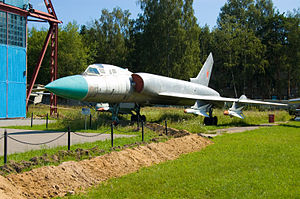Tupolev Tu-28 Video - Picture

|
|
Tupolev Tu-28
Tu-28 / Tu-128

Picture - A Tu-128 in a museum in Monino, Russia
Role: Interceptor
Manufacturer: Tupolev
First flight: 1959
Introduced: 1963
Retired: 1992 (Russia)
Status: Retired
Primary user: Soviet Air Defence Forces
Produced: 1963-1970
Number built: 188
The Tupolev Tu-28/Tu-128 (NATO reporting name Fiddler) was a long-range interceptor aircraft developed by the Soviet Union in the 1960s.
Design and development
In 1955 the PVO issued a specification for a long-range interceptor aircraft to defend the vast territory of the Soviet Union, which was so extensive that even with a far richer economy it would have been impossible to provide comprehensive land-based air defense. To provide the necessary range and ability to carry a powerful radar and air-to-air missiles, Tupolev developed an aircraft similar to the Tu-105 (Tu-22) bomber. Team leader for development of the Tupolev Tu-28 was "I. Nezval". The Tu-102 development aircraft first flew in 1959, with the initial operational version, the Tu-28P ('Fiddler-A'), entering production in 1963. This was replaced in production by the definitive Tu-128 ('Fiddler-B').
Based on the unsuccessful Tu-98 supersonic bomber, it had a broad, low/mid-mounted swept wing carrying the main landing gear in wing-mounted pods, and slab tailplanes. Two Lyulka AL-7F-2 turbojet engines were mounted in the fuselage. Unlike the Tu-22, there is no internal weapon bay. Weapons were carried on wing pylons, with the fuselage used for enormous fuel tanks. The Tu-28P seated two crew in tandem, with separate canopies.
The Tu-102 was thought by western experts to have a large ventral radar, but the bulge on the belly of the airplane actually carried testing instruments/equipment. The production Tu-28P had a large nose radome for an I-band search radar, known as Smerch ('Tornado'; (NATO reporting name 'Big Nose'), with a detection range of about 50 km (31 mi) and a lock-on range of about 40 km (25 mi). Despite the power of its radar, the aircraft was dependent on ground-control interception to vector pilots to their targets. In later years it often operated in partnership with Tu-126 AEW aircraft. As a pure interceptor the Tu-28P had almost no ECM or defensive avionics, not even a radar-warning receiver (RWR) like the smaller Sukhoi interceptors.
The Tu-128 was a pure patrol interceptor, and with its high wing loading, unsophisticated but reliable avionics, and poor visibility, as well as its sheer mass, was doubtless not an agile aircraft. It was intended primarily to combat NATO bombers like the B-52, not to dogfight with smaller aircraft.
Armament of the Tu-128 was four Bisnovat R-4 air-to-air missiles (NATO reporting name AA-5 'Ash'), usually two R-4R with semi-active radar homing and two R-4T infrared-homing missile, with the SARH rounds on the outer pylons and the heat-seekers on the inners. Despite the obsolescence of these missiles, they apparently were never replaced by newer weapons.
Production of the Tu-128 ended in 1970 with total 188 aircraft built. Further 10 of trainers were produced in 1971 and 4 converted from fighters, designated Tu-128UT, with an additional cockpit forward of the normal pilot's cockpit, in place of a radar. Upgrade projects, designated Tu-138 and Tu-148 by the design bureau, were abandoned before much progress was made.
Operational history

Picture - Tu-128 prototype
The Tu-28's only publicly reported combat operation was destruction of NATO reconnaissance balloons, but, as interceptions of reconnaissance and spy missions were generally not reported, there may have been other incidents that have never been disclosed. Although balloons cannot be a target for heavy missiles (at least an incident involves a "heavy missile-armed" fighter over the Kamchatka Peninsula in 1972, but never verified whether it was a Tu-28P or a Yak-28 (both being in service in that area and that era) by U.S. reconnaissance aircraft.
Two-thirds of all produced aircraft remained in service into the 1980s. The Tu-128 was gradually phased out in favor of newer aircraft like the Mikoyan-Gurevich MiG-25 and later MiG-31, although a few may have been retained (probably combat - trainers or DACT) as late as 1992.
As an interceptor (given its long range and missile armament) Tu-28P was also an escort to the Tu-126 "Soviet AWACS".
Variants
Tu-102 Development test aircraft, one built. Tu-28P ('Fiddler-A') First production variant. Tu-128 ('Fiddler-B') Definitive production version. Tu-128UT Training version with an additional cockpit forward of the normal pilot's cockpit, in place of a radar. 10 built and 4 converted from fighters. Tu-138 Upgrade project, abandoned in favour of other designs. Tu-148 Upgrade project, abandoned in favour of other designs.
Operators
Soviet Union
Soviet Anti-Air Defense
Specifications (Tu-128)
General characteristics
Crew: Two, pilot and radar operator
Length: 27.2 m (89 ft)
Wingspan: 18.1 m (59 ft)
Height: 7.0 m (23 ft)
Wing area: 80 m² (861 ft²)
Empty weight: 24,500 kg (54,013 lb)
Loaded weight: 40,000 kg (88,185 lb)
Powerplant: 2x— Lyulka AL-7F-2 turbojet, 107.9 kN [afterburner] (24,300 lbf) each
Performance
Maximum speed: Mach 1.65 at high altitude (1,740 km/h, 1,089 mph)
Range: 3,200 km (2,000 mi)
Service ceiling: 18,000 m (59,055 ft)
Rate of climb: 125 m/s (24,600 ft/min)
Wing loading: 500 kg/m² (102 lb/ft²)
Thrust/weight: 0.55
Armament
Missiles: 4 x— Bisnovat R-4 air-to-air missiles (usually 2 x— radar-guided R-4R and 2 x— infrared-homing R-4T)
List of fighter aircraft
List of military aircraft of the Soviet Union and the CIS
Related development
Tupolev Tu-22
Tupolev Tu-98
Comparable aircraft
Lavochkin La-250
Mikoyan-Gurevich MiG-25
Mikoyan MiG-31
Sukhoi Su-15
Yakovlev Yak-28
CF-105 Arrow
F-101 Voodoo
F-106 Delta Dart
Living Warbirds: The best warbirds DVD series.
Source: WikiPedia